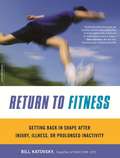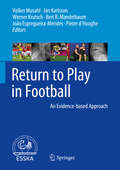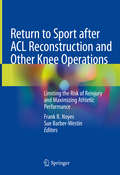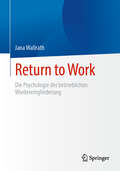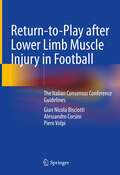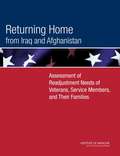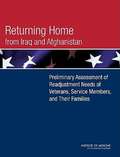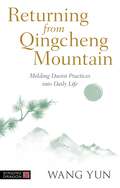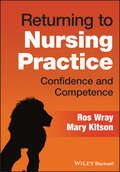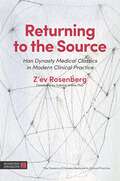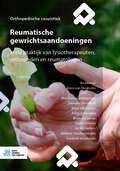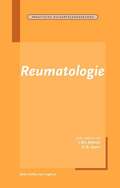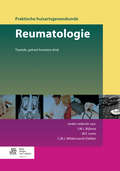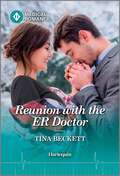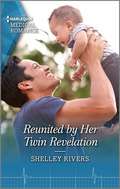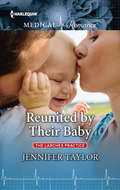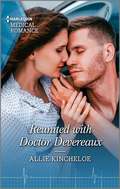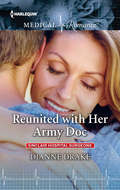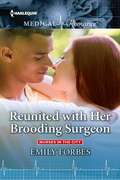- Table View
- List View
Return to Fitness
by Bill KatovskyFrom the coauthor of "Bike for Life" and founder of "Tri-Athlete Magazine," comes an indispensable guide to regaining health and fitness after illness, inactivity, or injury
Return to Play in Football: An Evidence-based Approach
by João Espregueira-Mendes Jón Karlsson Volker Musahl Pieter D'Hooghe Werner Krutsch Bert R. MandelbaumIn this book, leading experts employ an evidence-based approach to provide clear practical guidance on the important question of when and how to facilitate return to play after some of the most common injuries encountered in football. Detailed attention is paid to biomechanics, the female athlete, risk factors, injury prevention, current strategies and criteria for safe return to play, and future developments. Specific topics discussed in depth include concussion, anterior cruciate ligament and other knee injuries, back pathology, rotator cuff tears, shoulder instability, hip arthroscopy, and foot and ankle injuries. The chapter authors include renowned clinicians and scientists from across the world who work in the field of orthopaedics and sports medicine. Furthermore, experiences from team physicians involved in the Olympics, National Football League (NFL), Union of European Football Associations (UEFA), and Fédération Internationale de Football Association (FIFA) are shared with the reader. All who are involved in the care of injured footballers will find this book, published in cooperation with ESSKA, to be an invaluable, comprehensive, and up-to-date reference that casts light on a range of controversial issues.
Return to Sport after ACL Reconstruction and Other Knee Operations: Limiting the Risk of Reinjury and Maximizing Athletic Performance
by Frank R. Noyes Sue Barber-WestinThe wealth of information provided in this unique text will enable orthopedic surgeons, medical practitioners, physical therapists, and trainers to ensure that athletes who suffer anterior cruciate ligament (ACL) injuries, or who require major knee operations for other reasons, have the best possible chance of safely resuming sporting activity at their desired level without subsequent problems. Divided into seven thematic sections, the coverage is wide-ranging and encompasses common barriers to return to sport, return to sport decision-based models, and the complete spectrum of optimal treatment for ACL injuries, including preoperative and postoperative rehabilitation. Advanced training concepts are explained in detail, with description of sports-specific programs for soccer, basketball, and tennis. Readers will find detailed guidance on objective testing for muscle strength, neuromuscular function, neurocognitive function, and cardiovascular fitness, as well as validated assessments to identify and manage psychological issues. In addition, return to sport considerations after meniscus surgery, patellofemoral realignment, articular cartilage procedures, and knee arthroplasty are discussed. Generously illustrated and heavily referenced, Return to Sport after ACL Reconstruction and Other Knee Operations is a comprehensive resource for all medical professionals and support staff working with athletes and active patients looking to get back in the game with confidence.
Return to Work: Die Psychologie der betrieblichen Wiedereingliederung
by Jana WallrathDie Psychologie verfügt über einige bewährte Methoden, die auch im Kontext der betrieblichen Wiedereingliederung von Mitarbeiter*innen nützlich sind. Warum also auf ihren Einsatz verzichten? Das ist das Versprechen dieses Buches: Mit klaren Beschreibungen der Zusammenhänge und Hintergründe und mit dem Fokus auf die zurückkehrenden Mitarbeiter*innen erhalten alle am BEM-Prozess Beteiligten Zugang zu den wirksamsten psychologischen Werkzeugen. Damit werden die Akteur*innen im Unternehmen noch wirksamer darin, die Fachkräfte als wichtigste Ressource zu erhalten und die positive Unternehmenskultur weiterzuentwickeln. So wird das Ziel, Krisen zu meistern und gestärkt aus ihnen hervorzugehen, sicher erreicht.
Return-to-Play after Lower Limb Muscle Injury in Football: The Italian Consensus Conference Guidelines
by Piero Volpi Gian Nicola Bisciotti Alessandro CorsiniReturn to training (RTT) and return to play (RTP) decisions making process in football are currently based on expert's opinion. However, there are no consensus guidelines on evidence-based decision-making. This book provides a framework for evidence-based decision-making both in RTT and RTP following lower-limb muscle injuries sustained in football.Based on the “Italian Consensus Conference (2019) on return-to-play after lower limb muscle injury in football”, it provides a list of RTT and RTP criteria after such injuries compiled by orthopedic surgeons, sports physicians, radiologists, rehabilitation physicians, sport physiologists, general surgeons, family physicians, physiotherapists, physical trainers and psychologists working in elite football in Italy.The book identifies the main criteria for RTT and RTP following injuries involving the most important muscle groups, i.e. quadriceps, hamstring, hip adductor, hip external rotator, iliopsoas and soleus-gastrocnemius.As such it is a valuable reference resource for practitioners making RTT and RTP decisions making process.
Returning Home from Iraq and Afghanistan
by Institute of MedicineAs of December 2012, Operation Enduring Freedom (OEF) in Afghanistan and Operation Iraqi Freedom (OIF) in Iraq have resulted in the deployment of about 2. 2 million troops; there have been 2,222 US fatalities in OEF and Operation New Dawn (OND)1 and 4,422 in OIF. The numbers of wounded US troops exceed 16,000 in Afghanistan and 32,000 in Iraq. In addition to deaths and morbidity, the operations have unforeseen consequences that are yet to be fully understood. In contrast with previous conflicts, the all-volunteer military has experienced numerous deployments of individual service members; has seen increased deployments of women, parents of young children, and reserve and National Guard troops; and in some cases has been subject to longer deployments and shorter times at home between deployments. Numerous reports in the popular press have made the public aware of issues that have pointed to the difficulty of military personnel in readjusting after returning from Iraq and Afghanistan. Many of those who have served in OEF and OIF readjust with few difficulties, but others have problems in readjusting to home, reconnecting with family members, finding employment, and returning to school. In response to the return of large numbers of veterans from Iraq and Afghanistan with physical-health and mental-health problems and to the growing readjustment needs of active duty service members, veterans, and their family members, Congress included Section 1661 of the National Defense Authorization Act for fiscal year 2008. That section required the secretary of defense, in consultation with the secretary of veterans affairs, to enter into an agreement with the National Academies for a study of the physical-health, mental-health, and other readjustment needs of members and former members of the armed forces who were deployed in OIF or OEF, their families, and their communities as a result of such deployment. The study consisted of two phases. The Phase 1 task was to conduct a preliminary assessment. The Phase 2 task was to provide a comprehensive assessment of the physical, psychologic, social, and economic effects of deployment on and identification of gaps in care for members and former members, their families, and their communities. The Phase 1 report was completed in March 2010 and delivered to the Department of Defense (DOD), the Department of Veterans Affairs (VA), and the relevant committees of the House of Representatives and the Senate. The secretaries of DOD and VA responded to the Phase 1 report in September 2010. Returning Home from Iraq and Afghanistan: Assessment of Readjustment Needs of Veterans, Service Members, and Their Families fulfills the requirement for Phase 2.
Returning Home from Iraq and Afghanistan: Preliminary Assessment of Readjustment Needs of Veterans, Service Members, and their Families
by Institute of Medicine of the National AcademiesNearly 1.9 million U.S. troops have been deployed to Afghanistan and Iraq since October 2001. Many service members and veterans face serious challenges in readjusting to normal life after returning home. This initial book presents findings on the most critical challenges, and lays out the blueprint for the second phase of the study to determine how best to meet the needs of returning troops and their families.
Returning from Qingcheng Mountain: Melding Daoist Practices into Daily Life
by Wang YunFunctioning as both a dense manual, a detailed roadmap, and an edifying tale of spiritual maturity, this third instalment in Wang Yun's best-selling series brings you rare and authentic Daoism, straight from the culture that gave birth to it. With clear instruction and dozens of illustrated and filmed exercises, you can begin or strengthen your spiritual practice, boost your immune system, and find deep peace of mind, all right from the comfort of your home.Lofty Daoist philosophy and its practical applications are made easy to grasp and apply through Wang Yun's effort to translate the old teachings on how to apply the mindset and skills of Daoist meditation, alchemy and qigong to all affairs of life. To this end, Returning from Qingcheng Mountain spins a blend of rare tales from Daoist lore, straightforward explanations of ways to shape the body and mind, and inspiring stories from Wang Yun's own practice path.To 'remain natural in all things' is the tenet that pervades every page, an eternal invitation toward being at ease, no matter the circumstances. By doing so, one returns to the world out there and handles mundane matters with poise and efficiency, transforming all the challenges and joys and relationships of daily life into a practice, a meditation, and a chance to grow and develop one's spirit, and by token, the body.
Returning to Nursing Practice: Confidence and Competence
by Ros Wray Mary KitsonReturning to Nursing Practice Navigate every step of returning to nursing practice with this accessible guide Returning to Nursing Practice offers a step-by-step guide to navigate the challenges of returning to work after a practice break. It advocates renewed career pathways in healthcare for nurses rediscovering their professional identity and confidence. Common features of RTP courses are discussed including updating study and clinical skills and the importance of reflective practice. The book highlights the practical, psychological, and community-oriented aspects of returning to the profession and is an invaluable resource for any nurse considering or embarking on this journey. Returning to Nursing Practice readers will also find: Content designed to re-familiarise the returning nurse with updated healthcare practice An easy-to-use and readable style, supplemented throughout with figures and illustrations, and hints and tips from previous returners Careful attention to the student and practice assessor relationship, and the value of peer support, and well-being Returning to Nursing Practice is essential for nurses undertaking RTP courses and lapsed registration nurses considering a return to practice.p>
Returning to the Source: Han Dynasty Medical Classics in Modern Clinical Practice
by Professor Z'Ev Rosenberg Ken Rose Dr Sabine Wilms Blair ThornleyChinese Medicine constantly refers back to its sources in order to initiate the new. Its source code is in the Han Dynasty medical classics, and in this handbook esteemed practitioner and educator Professor Z'ev Rosenberg shares the knowledge from his study of these classic texts and his experiences treating difficult cases. In the tradition of the scholar-physician commentaries, Z'ev Rosenberg comments on the Simple Questions that introduce the core principles of the Inner Canon; explaining how these inform his methodology of diagnosis and advising on how biomedical diseases can be retranslated into sophisticated Chinese medical diagnoses including patterns of differentiation, sequential diagnosis, synchronicity, season, climate and environment. He discusses how Chinese medicine can use unique diagnostic parameters to rebalance the landscape and chronobiology of the body and address the greatest clinical challenges of our time, including the contemporary epidemic of autoimmune disorders.
Reumatische gewrichtsaandoeningen: In de praktijk van fysiotherapeuten, orthopeden en reumatologen (Orthopedische casuïstiek)
by Koos Van NugterenGewrichtspijn kan allerlei oorzaken hebben. In veel gevallen is er sprake van een orthopedische probleem. Soms echter ontstaat er spontaan gewrichtspijn en blijkt pas na vele onderzoeken en behandelingen dat de patiënt een reumatische aandoening heeft. Dit kan voor de orthopedisch georiënteerde (para)medicus verraderlijke valkuilen opleveren en niet zelden wordt de juiste diagnose pas laat ontdekt. Het is dan ook van belang als (para)medicus om enige kennis te hebben van reumatische aandoeningen zodat bij verdenking hiervan de patiënt snel doorgestuurd kan worden naar de reumatoloog. In deze uitgave van ‘Orthopedische Casuïstiek’ worden relatief veelvoorkomende gewrichtsaandoeningen behandeld met een reumatische oorzaak. Aan bod komen onder andere: jeugdreuma, reumatoïde artritis, axiale en perifere spondyloartritis, bacteriële artritis, ziekte van Lyme, spondylodiscitis, polymyalgia reumatica, jicht, chondrocalcinose, primaire artrose, en spondylitis ankylopoetica. Zoals gebruikelijk in de boekenreeks van Orthopedische Casuïstiek wordt ieder onderwerp besproken aan de hand van patiëntencasuïstiek uit de dagelijkse praktijk. De tekst is rijk geïllustreerd met educatieve tekeningen en foto’s. Het boek is in het bijzonder bestemd voor fysiotherapeuten, kinesitherapeuten, artsen en orthopeden.
Reumatologie
by W. F. Lems A. Prins A. De Sutter P.J.E. Bindels R.M. van Soesbergen H. S. Miedema J.W.J. Bijlsma B. Hillen F. C. Breedveld A.C. de Jongh E. Lindeman A. A. Kruize A.A.M. Blaauw A. J. Evertse R.M. van Vugt H.C.M. Haanen A. C. Hendriks H. M. Markusse K. J. Gorter C.H.M. van Ende S.T.M. Terwindt M.J. van Veen J.W.G. Jacobs M. H. Steenks J.W. van Ree M.C. de Waal Malefijt B.A.C. Dijkmans J. Buis J.O.M. Zaat K. H. Njoo Th. B. Voorn A.M.E. Bos W.J.H.M. van Bosch J. Van Damme P.L.C.M. van Riel J.M.J.P. van Linden A.A. Heins van Valburg B. Tent A.C.M. Romeijnders D. Bijl D.R. Siewertsz van Reesema E. Taal R.F.J.M. Laan S.H.M. Janssen J. J. Rasker A. A. Matser M.A.F.J. Laar J.P.M. DenekensDit is een boek over Reumatolgie.
Reumatologie (Praktische huisartsgeneeskunde)
by Bevers K. M. Kloppenburg P. Geusens H. Bootsma R. Geenen A. Vlietstra N. Vorwald I. Hussaarts J. Galavazi M. Hollander W.F. Lems A.A.M. Blaauw F. A. van Gaalen D.L. Boumans N.M.A. van Dillen D.L. Baeten J.M. van Laar J.F. Swart D.L. Vosse T.L. Jansen J.W.G. Jacobs H.J.L. van der Heide C.H.M. van den Ende Y.J.L. van Eijk-Hustings R.J.E.M. Dolhain M.P.T. de Wit A.E.R.C.H. Boonen I.C. Lether A.J. van der Veer J.P.W. van den Berg J.N. Belo M.K. Janssen J.O.M. Zaat R.M.M. Kievits-Smeets R.M. van Hemert D.W.M. Lucassen D.P. Shackleton A. van Slobbe W.H. Bos J.M. Meijer N.J. van Es W.D. Boswinkel C.J. Haagsma G.B.J. Hurenkamp S. de Jong M.A.F.J. van de Laar H.A. Martens C.T. Ouden E.J.A. Raaijmakers-De GrootDeze tweede, compleet herziene editie van Reumatologie is niet zozeer geschreven vanuit een aandoening, maar vanuit de klacht en de daarbij behorende casuïstiek. Vrijwel alle hoofdstukken zijn in nauwe samenwerking tussen reumatoloog en huisarts tot stand gekomen. Nadrukkelijk komt aan bod wat de huisarts zelf kan doen, en wanneer verwijzing naar de tweede lijn gewenst, of zelfs noodzakelijk is. Op deze manier is de relevantie voor de huisartspraktijk gegarandeerd.Het boek is opgebouwd uit een aantal clusters. Na algemeen inleidende hoofdstukken volgt een klachtgericht deel. De klachten zijn ingedeeld naar lokalisatie en worden geïllustreerd met casuïstiek. Daarna volgt een ziektegericht deel waarin de belangrijkste reumatische ziektebeelden worden beschreven. Ten slotte is er een therapiedeel waarin alle mogelijkheden uitgebreid aan bod komen.Reumatologie verschijnt in de reeks Praktische huisartsgeneeskunde. In deze reeks verschijnen uitgaven met praktische en klachtgerichte informatie over de verschillende deelgebieden van de huisartsgeneeskunde.Reumatologie is in de eerste plaats geschreven voor huisartsen, al dan niet in opleiding, maar ook basisartsen/medisch studenten en reumaverpleegkundigen/verpleegkundig specialisten zullen hier veel relevante informatie in kunnen vinden.
Reunion with His Surgeon Princess
by Karin BaineShe ran from his proposal……but fate isn’t through with them yet!World-renowned transplant surgeon and single dad Seth Davenport will do everything to save his royal patient. Even if that means a reunion with his patient’s daughter—Princess Kaja Alderisi, the surgeon who once ran from him…after he’d offered her a diamond ring and his heart! But one look into Kaja’s captivating gaze and it’s clear that their past isn’t so willing to be left behind…
Reunion with the ER Doctor (Alaska Emergency Docs #1)
by Tina BeckettIn the first installment of the Alaska Emergency Docs duet, the doctor is reunited with the one who got away—when she becomes his new colleague! EMERGENCY! THE DOCTOR&’S EX IS BACK… Having migrated from one foster home to another as an orphaned teenager, Dr. Eli wants only a forever family. But when his short-lived marriage ends, he simply craves escape… Anchorage Memorial Hospital should be his refuge, until Dr. Georgia arrives, his new colleague—and ex-girlfriend! Commitment-phobe Georgia broke his heart once. Is this an opportunity to let go of the past…and fight for a future together? From Harlequin Medical: Life and love in the world of modern medicine.Alaska Emergency Docs Book 1: Reunion with the ER Doctor by Tina BeckettBook 2: One-Night Baby with Her Best Friend by Juliette Hyland
Reunited by Her Twin Revelation
by Shelley Rivers&“I just want to talk.&”Is he ready to hear her secret?Nurse Thurza had pictured this day thousands of times. The day that Dr. Logan would return. Still, nothing could have prepared her for the real thing… Why? Well, when a mix-up led a brokenhearted Thurza to falsely believe that he had abandoned her and their unborn babies, she said goodbye to Logan—forever. But, as their past and the truth begin to unravel, will Thurza let Logan back in? &“…I really enjoyed it. Shelley has a great talent for storytelling, and her writing is full of quality. I loved the way she constructed and executed her storyboard and her character development was absorbing and detailed with diverse characters that I immediately liked. I thought the ending rounded off the story very well. This is a feel good, easy and satisfying read.&”-Goodreads on Awakening His Shy Vet &“This was a great book. I really liked the animal involvement and the work romance. This was such an easy and relaxing read.&”-Goodreads on Tempted by the Brooding Vet
Reunited by Their Baby: Healed By The Midwife's Kiss (the Midwives Of Lighthouse Bay, Book 2) / Reunited By Their Baby (the Larches Practice, Book 3) (The\larches Practice Ser. #3)
by Jennifer TaylorHe’s back to claim his family…But can Beth trust him with her heart?GP Beth Andrews has a wonderful job at The Larches Practice and a baby girl she adores. The only thing missing is her husband! Now Callum O’Neill is back and he’s stunned and delighted to discover he has a much-wanted child. He’s determined to renew his marriage with Beth, but can she trust that this time he’ll stay forever?
Reunited by Their Pregnancy Surprise
by Louisa HeatonReclaiming his wife...and his baby! Obstetrician Sam Saint wakes in hospital after an accident to find he doesn't remember the past eighteen months. The beautiful woman by his bedside is in fact his wife...and she's pregnant! Midwife Emily never thought her husband would want the child she longs for. But now that she's expecting his baby, she's determined to fight for their marriage. And as they rediscover each other, Emily and Sam find themselves making new memories-ones they'll both treasure forever!
Reunited by Their Secret Daughter: Reunited By Their Secret Daughter (london Hospital Midwives) / A Fling To Steal Her Heart (london Hospital Midwives) (London Hospital Midwives #3)
by Emily ForbesHer three-year-old secret……is about to be revealed!Between her job with Queen Victoria’s Air Ambulance and raising her three-year-old daughter, midwife Chloe Larson’s too busy to find love. Only maybe love has found her… Xander Jameson—the gorgeous Australian doctor she had a fling with and who disappeared without a trace—has joined her team! The attraction is definitely still there. But first, Chloe must tell Xander he’s a father.A London Hospital Midwives novelLondon Hospital Midwives quartetBook 1 — Cinderella and the Surgeon by Scarlet WilsonBook 2 — Miracle Baby for the Midwife by Tina BeckettBook 3 — Reunited by Their Secret Daughter Book 4 — A Fling to Steal Her Heart by Sue MacKay“Overall, Ms. Forbes has delivered a delightful read in this book where emotions run high because of everything this couple go through on their journey to happy ever after…and where the chemistry between this couple was strong; the romance was delightful and had me loving these two together….”—Harlequin Junkie on Rescued by the Single Dad“This is the best book I’ve read by Ms. Forbes so far and I was hooked right from the beginning….”—Harlequin Junkie on Reunited with Her Brooding Surgeon
Reunited in the Snow: His Surgeon Under The Southern Lights (doctors Under The Stars) / Reunited In The Snow (doctors Under The Stars) (Doctors Under the Stars #2)
by Amalie BerlinLeft at the altar……reunited under the stars!In this Doctors Under the Stars story, Lia Monterrosa arrives at the Antarctic science station as resident staff doctor… and comes face-to-face with her ex fiancé! Working in close confines means brooding Dr. Weston MacIntyre can’t hide the painful reason he left Lia at the altar much longer. Lia knows she must guard her heart — especially as desire as bright as the Southern Lights still blazes between them!Doctors Under the Stars duetBook 1 — His Surgeon Under the Southern LightsBook 2 — Reunited in the Snow“…Ms. Berlin pens a fantastic read in this story filled with intense moments…the romance was delightful and had me loving these two together….”— Harlequin Junkie on Rescued by Her Rival“…I’ve got to say that this story is entertaining and took me on a rollercoaster of emotion…. Overall, Ms. Berlin has delivered a really good read in this book where the chemistry between this couple is tangible from the moment they meet and just keeps getting stronger….” — Harlequin Junkie on Healed Under the Mistletoe
Reunited with Doctor Devereaux
by Allie KincheloeAn unexpected reunion…A second chance at love?Years ago, trauma surgeon Danny Owens broke his promise and broke GP Camilla Devereaux&’s heart. Now Danny is back. The terms of his late father&’s will mean Danny and Camilla have to work together for the next six months. They loved each other once, and it&’s clear there&’s still something burning between them. Can they leave the past behind and embrace the bright future they deserve…together? "I loved the couple, their history and the pacing of their romance which was pitched just right.... Allie Kincheloe is an author I&’ll definitely be reading more from in the future."-Goodreads on Heart Surgeon's Second Chance
Reunited with Her Army Doc
by Dianne DrakeCan he trust her with his heart?Army doc Caleb Carsten will do anything for his gifted son—even if it means returning to his hometown of Marrell and working for Leanne Sinclair, the childhood crush who once broke his heart.Leanne is thrilled to meet Caleb again. But why can’t she remember more about their past, and what she did to hurt him so badly? And if Leanne can’t show Caleb she’s changed, will he ever trust her with his heart?
Reunited with Her Brooding Surgeon (Nurses in the City #1)
by Emily ForbesHe’s kept love at bay…Can she unlock his heart?In this Nurses in the City story, Grace Gibson loves her job as a transplant coordinator at a Sydney hospital. But she’s blindsided when a ghost from her past reappears. Devastatingly handsome surgeon Marcus Washington was her childhood neighbor—but he’s all man now, and hiding a wealth of pain. Will Grace be the woman to break down his walls and claim his heart?
Reunited with Her Daredevil Doc: A Wedding For The Single Dad / Reunited With Her Daredevil Doc (Mills And Boon Medical Ser.)
by Susan CarlisleAn old flame……a new beginning?Dana Warren almost doesn’t recognize the man Dr. Travis Russell has become. He’s far from the carefree guy she once spent an unforgettable summer with years ago as they trained to save lives and fight wildfires. Now an experienced smoke jumper, Dana must take the guarded doc through stunning but dangerous wilderness to reach a vulnerable patient—and take care not to lose her own scarred heart along the way…From Harlequin Medical: Life and love in the world of modern medicine.
Reunited with Her Hot-Shot Surgeon: The Army Doc's Secret Princess / Reunited With Her Hot-shot Surgeon (Mills And Boon Medical Ser.)
by Amy RuttanOnly one surgeon can save her patient—The one she left behind.Pearl Henderson and Calum Munro were best friends, too focused on becoming orthopedic surgeons for a relationship—until one night led to an unexpected pregnancy. But when they tragically lost their unborn baby, Pearl ran, the guilt too hard to bear. Returning to San Francisco for a high-profile case proves time’s a powerful healer. But it’s also intensified her attraction to the man she had never wanted to leave…
